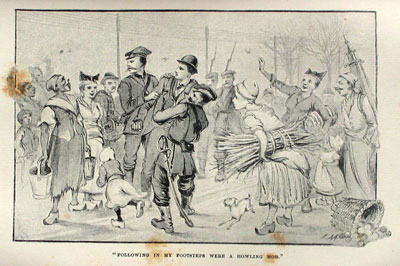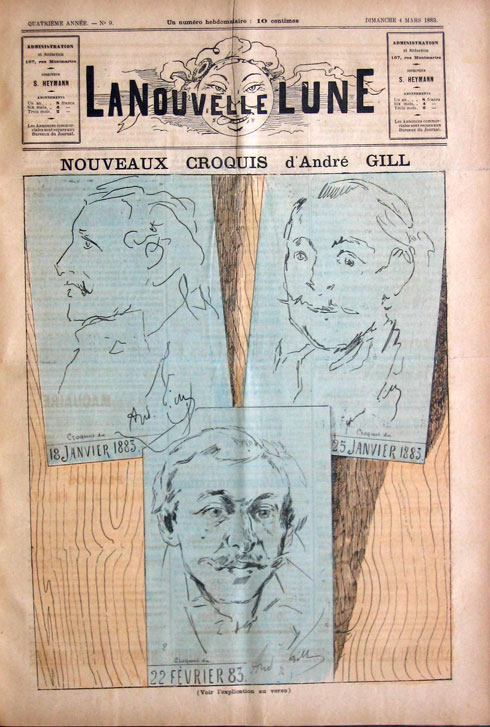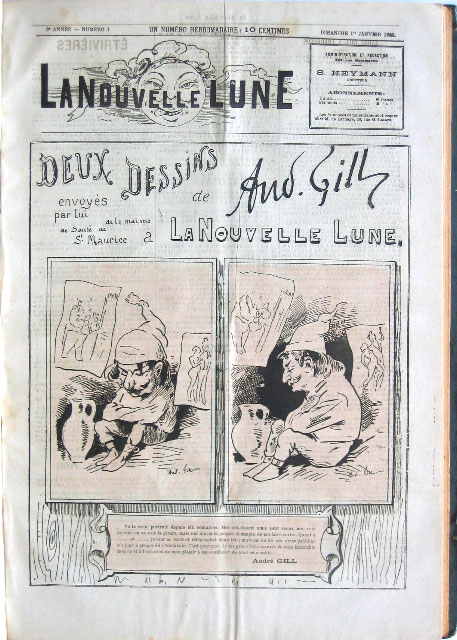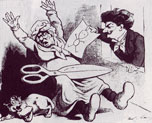The following text was commissioned by the Spanish artists magazine
Centro de Bajo Rendimiento“ for proyecto editorial No.1, 2008
www.centrodebajorendimiento.com
Special thanks go to Toni Crabb.
I. Unfinished
The first drawing ever published in a state of declared unfinishedness appeared on November 28th, 1891, in the globally distributed magazine „The London Illustrated News“. In his memoirs, the author of the drawing, the American artist Joseph Pennell, describes the circumstances of the emergence and publication of what he calls an „interrupted sketch“.

Joseph Pennell, In The Streets Of Berdicheff: An Interrupted Sketch, The Illustrated London News, 1891
In the spring of 1891, Pennell – a staunch racist – had travelled to Russia to explore the living conditions of the Eastern jews in order to launch an antisemitic report. Whilst making a sketch of a crowded marketplace in Berditchev in the Northern Ukraine, he was arrested by two Cossack policemen under the suspicion of being a military spy. Back in London, he offered his drawings to several magazines. They were accepted by the worldwide leading illustrated journal to which in preceding years he had regularly contributed travel reports: „The first Berditchev drawing was published in´The Illustrated London News´, after the editor, Clemens K. Shorter had asked me to´finish it´, he being, of course, unable to appreciate that it was a record of fact; it was the first sketch ever printed in that paper and had much to do with revolutionizing and freeing illustrated journalism from `finish´.“
Pennell was not only known as an influential illustrator, but also as an early historian and prolific writer on the art of illustration and on various printing techniques. So there is no way for him to ignore that his statement to have made the first sketch ever published in this venerable magazine was very far from being true. By the beginning of the 1890s, illustrated journalism, which had started with the „Illustrated London News“ in 1842, could look back on a long period of nearly thirty years of reproducing rough sketches by reporter artists known as “specials“ or „special artists“.
The 1850s had seen the rise of drawn reportage during the big event of the Crimean war, which had been staged as a picturesque media spectacle. Constantin Guys, who worked for French and British journals, had developed a very rough, stenogram-like sketching style mixing scribbles with written notes, in order to record his impressions of the swift military actions. Charles Baudelaire was very impressed by the topicality of Guys’s art and recognized in him the protoype of a new kind of artistic strategy which he called „modernité“. But the loose sketches of Guys and his likes were published in a completely transformed, unifying mode, translated into a conventional finished standard by editing draughtsmen and xylographers who worked in the factory-like art departments of the magazines. However, this period of editing was not to last very long. With the invention of photoxylography in the early 1860s it became more and more common to expose photos of the original sketches directly onto the woodblocks in order to preserve individual drawing styles and to execute facsimiles.
The effect of these new technical possibilities meant an improvement of the position of the ‚special artists’, who now began to sign what had previously been anonymous works. The 1870s saw the rise of a star cult of leading magazines’ main artists – among them Melton Prior, who covered more than 25 colonial wars for the “London Illustrated News“. Between campaigns, he would exhibit his drawings and hold lectures.

Melton Prior, Lecture on the Egyptian War by Mr. Melton Prior,
The Illustrated London News, 1883
Prior developed a kind of snappy sketching style with handwritten inscriptions and captions that became an oft-imitated trademark. Among his many followers was also American illustrator Joseph Pennell, who fused Prior’s style with the manner of his teacher James Abbot McNeill Whistler.
So the act of publishing Pennell’s unfinished sketch itself can in no way be called innovative. However, what was indeed revolutionary was the concept of the drawing. From the days of the French-Prussian War, the act of getting arrested, together with a descriptive drawn document that stages this performance in a most effective way, was the best way to make a name for yourself as a reporter. Especially in the claustrophobic and paranoid situation of Paris under siege where numerous members of the international press were confined, even the slightest indication of making notes could give rise to moblaw or imprisonment. In decades to follow, the image of a special artist just getting arrested, drawn by himself from memory or drawn by a colleague, became topical in the pictorial press and nearly no reporter-artist-star would go without this central trophy of his craft.

William Simpson, Arrest of English Correspondents at Metz,
The Illustrated London News 1870

Melton Prior, Arrest of our Special Artist Melton Prior at Ragusa,
The Illustrated London News 1875

Irving Montague, Howling Mob (1871), Wanderings of a War Artist,
London 1889
However, unlike all former documents of arrested artists, the Pennell drawing is not an illustration of this act. Instead, it turns the temporal aspect of a transient sketch into a certificate of the artistic performance. The arrest itself was quite harmless and lasted only a few hours (and not thirty-six hours, as the subtitle of the drawing indicates), but the staging of the arrest was as effective as it could be in declaring an ordinary, loose sketch „interrupted“.
Pennell’s sketch is unique in that it reflects in an extremely condensed form the two main aspects of the art of the „specials“ in the second half of the 19th century: its being time-based and its stressing of the instantaneous, as well as its tendency to self-reflective performance.
II. Discarded
On Sunday, the fourth of March, 1883, the French satirical journal „La Nouvelle Lune“ did not appear with the usual weekly caricature on its cover, but with a facsimile wood engraving of three portrait drawings. They looked quite unprofessional, as if made by somebody who takes pains in executing a satisfying portrait. Whereas the unaccomplished style was quite surprising in the context of a cover illustration, the name of the author, André Gill, was very familiar to the reader. Gill was the leading caricaturist of the second half of the 19th century in France, the founder of a new school of a very sophisticated emblematic style of political cartooning that specialized in a virtuoso, biting kind of portrait caricature. Gill had been the editor of various magazines like „La Lune“, „La Lune Rousse“ or „L’Eclipse“, which became famous for their constant struggle with censorship in the eras of the Second Empire and the Third Republic.

André Gill, Nouveaux Coquis, La Nouvelle Lune, 1883
„La Nouvelle Lune“ had been founded by followers and admirers of André Gill, but, owing to his increasing ambitions as a painter and poet, the contributions expected from him and announced at the start of the journal’s publication became very rare. The last caricatures by him to be seen on the cover were from January 1st of the previous year. The two rough sketches showed Gill himself surrounded by his drawings, dressed in a nightgown, with shackles on his feet.

André Gill, Deux Dessins,La Nouvelle Lune, 1882
The image of the incarcerated caricaturist was a familiar topos of a craft that lived under the constant threat of accusations of libel, but here the caption read that Gill’s residence was not a prison cell but a hospital. Rumours spread and finally proved true that the famous artist whose popular logos had been the eclipse and the ill-omened moon of insanity had suffered from a mental breakdown and was locked up in a lunatic asylum.

Logo of “La Lune”

Logo of “L´Eclipse”
So the set of portraits, published on March 1883, which on closer examination showed three different states of unaccomplishment, turned out to be a demonstration of a gradual improvement of Gill’s mental condition. But the confidence of his disciple and friend Emile Cohl, who had featured the portrait drawings in his journal and whose likeness Gill had tried to capture, failed. Gill finally died in the mental institution of Charenton in 1885 in a state of constant paralysis.
But while Gill vegetated though various states of insanity, he, whose continuous fight against censorship together with his various literary ambitions had formerly created a sense of identity in early Bohemian Montmartre culture, became the godfather and martyr of an artistic movement that is lately being considered the hotbed of the series of so called „revolutionary“ artistic movements of the 20th century starting with Dada and Surrealism and certainly not ending with Fluxus.
Combining diverse artistic disciplines such as poetry, acting, painting, sculpturing and illustration, this large grouping called itself „Les Arts Incohérents,“ and their declared intention was to form a merrily anarchic opposition against the withering, restricted professionalism of the official art world. Their first show took place in September 1883, six months after the publication of Gills inept drawings, in the same gallery where a few month later a benefit auction of Gill’s assets would take place. It was advertised as „ an exhibition of drawings by people who do not know how to draw,“ and its success was immense. More than 20 000 visitors surged into this central cultural event of the Paris society.
Whereas the reference to Gill in this initial exhibition was only to be found between the lines, – the decline of his professional drawing ability had obviously served as the ultimate example of the formation of a primary incoherent artistic quality – it was an explicit one in the subsequent show, which took place in 1886: The cover of the comprehensive catalogue, which was designed by Cohl, showed a person in a state of exaltation, about to be engulfed by the moon of insanity. Every visitor of the show was able to grasp the dramatic dimension behind this surface of gaiety and nonsense.

Emile Cohl, Cover of Catalogue illustré des
Exposition des Arts Incoherents, 1886
Most artworks that the Incohérents had displayed in their influential series of a total of four exhibitions had their origins in the subversive strategies of caricature culture whose long history dates back to the times of the Renaissance. Caricature culture was the huge incubator in which all kinds of despised, discarded and banned imagery were assimilated, refined and guised against the prosecutions of censorship. By the end of the 19th century its languages had reached a height of differentiated ways of expression and a richness of cryptic visual vocabulary that have never been matched since. The spectrum ran from severe kinds of raging punches with extreme deformations and deconstructions to subtle observations and complex mappings of hidden meanings with rebus-like images; concrete poetry was included, monochromy and collages, dreamlike nonsense, crude drawing styles in rough broadsheet-manners, mock salon art, mock advertising, as well as childish scribblings and remains of ambulant graffiti art, dating back from the early times of British radicalism. Caricaturists like Emile Cohl, Alfred le Petit, Albert Robida or Caran d’Ache, all members of the Incohérents, had a range of visual resources at their fingertips whose possibilities far exceeded those of Fine Art.
„Les Arts Incohérents“ marked a very crucial state of overlap, where the strange coded imagery of Caricature culture started to expand into the realms of highbrow art. But the fight against the scissors of Madame Anastacia, the purblind personification of censorship, who often was fooled by Gill and his likes, would no longer be an exterior one, – just as the concepts of „écriture automatique“ and of „art brut“ would only be a very short step further into the final loop of lapin agile.

Artistide Boulineau, Cap, Catalogue illustré des Exposition
des Arts Incoherents, 1886

Leon Sargues, Pain d´aprés nature. Catalogue illustré des Exposition
des Arts Incoherents, 1886

André Gill, un dessin de Gill, La Lune Rousse, 1878
